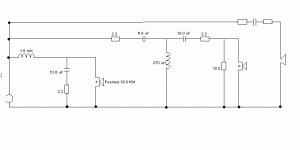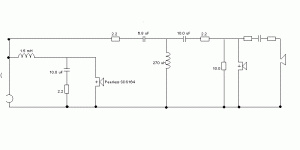I have this:
A TW consisting of a Peerless SDS-164-THP (830657) and a Hivi research X1-A. Crossover:
I want badly to add a supertweeter. The X-1A is a nice tweeter but it's just not punching up in to that "sparkle zone" I want to hear.
How can I wire this up? Especially with a minimum to no(?) changing the existing x.o. in the box? What's the best (cheap) supertweeter? I intend to mount it in a separate small enclosure sitting on top of the main cabs.
A TW consisting of a Peerless SDS-164-THP (830657) and a Hivi research X1-A. Crossover:
An externally hosted image should be here but it was not working when we last tested it.
I want badly to add a supertweeter. The X-1A is a nice tweeter but it's just not punching up in to that "sparkle zone" I want to hear.
How can I wire this up? Especially with a minimum to no(?) changing the existing x.o. in the box? What's the best (cheap) supertweeter? I intend to mount it in a separate small enclosure sitting on top of the main cabs.
Vifa XT19 is sweet, highest quality and affordable
Vifa XT19TD00-04 3/4" Ring Radiator Tweeter from Madisound
Just mount a small cap on XT19 terminal
+ or - ? I dont know
You may need a small series resistor
Mounted between cap and tweeter it makes the cap bigger, sort of
Within limits you may be able to fine adjust rolloff and precense with this resistor
Maybe try it as OMNI, which means the tweeter plays upwards
Or try it back mounted
Just wire it all to speaker main terminals
Or you can try to connect it directly to main tweeter terminals, but may need a resistor in between, but could be more tricky, dont know
edit, another one http://www.parts-express.com/pe/showdetl.cfm?Partnumber=264-735
#
Vifa XT19TD00-04 3/4" Ring Radiator Tweeter from Madisound
Just mount a small cap on XT19 terminal
+ or - ? I dont know
You may need a small series resistor
Mounted between cap and tweeter it makes the cap bigger, sort of
Within limits you may be able to fine adjust rolloff and precense with this resistor
Maybe try it as OMNI, which means the tweeter plays upwards
Or try it back mounted
Just wire it all to speaker main terminals
Or you can try to connect it directly to main tweeter terminals, but may need a resistor in between, but could be more tricky, dont know
edit, another one http://www.parts-express.com/pe/showdetl.cfm?Partnumber=264-735
#
Last edited:
So the cap on the xt19 terminal... series or parallel? I'm guessing it's parallel? then the series resistor between the cap and the tweeter on the pos lead?
What's a good ballpark for resistor value so I know what scale of pot to buy? I'm assuming after I know approx R value I can buy a linear pot to find my fine tuning? This totally bypasses the existing crossover??
What's a good ballpark for resistor value so I know what scale of pot to buy? I'm assuming after I know approx R value I can buy a linear pot to find my fine tuning? This totally bypasses the existing crossover??
So do the attenuating resistors go before or after the cap?
Depends
Some use a series resistor on both sides of cap
I wouldnt use traditional L-pad with paralel resistor
Just use series resistor only
1. Resistor between cap and tweeter makes the cap seem bigger, meaning rolloff will be lower than wiithout the resistor
Higher impedance results in smaller cap fore the sam xo point
Meaning that when increasing tweeter impedance with a series resistor results in slightly lower xo point fore a fixed cap value
Theres both pros and cons doing that
2. The series resistor before the series cap is easier to change value without effecting series cap as much
3. All in all this means that with the first resistor you can change attenuation only
And with the resistor after series cap you can fine adjust both capacitor, AND attenuation
I have doubts about second attached xo
Attachments
Last edited:
Depends
Some use a series resistor on both sides of cap
I wouldnt use traditional L-pad with paralel resistor
Just use series resistor only
1. Resistor between cap and tweeter makes the cap seem bigger, meaning rolloff will be lower than wiithout the resistor
Higher impedance results in smaller cap fore the sam xo point
Meaning that when increasing tweeter impedance with a series resistor results in slightly lower xo point fore a fixed cap value
Theres both pros and cons doing that
2. The series resistor before the series cap is easier to change value without effecting series cap as much
3. All in all this means that with the first resistor you can change attenuation only
And with the resistor after series cap you can fine adjust both capacitor, AND attenuation
I have doubts about second attached xo
Excellent tinitus, thanks so much. What do you think my starting values for the resistors should be?
Depends
Some use a series resistor on both sides of cap
I wouldnt use traditional L-pad with paralel resistor
Just use series resistor only
1. Resistor between cap and tweeter makes the cap seem bigger, meaning rolloff will be lower than wiithout the resistor
Higher impedance results in smaller cap fore the sam xo point
Meaning that when increasing tweeter impedance with a series resistor results in slightly lower xo point fore a fixed cap value
Theres both pros and cons doing that
2. The series resistor before the series cap is easier to change value without effecting series cap as much
3. All in all this means that with the first resistor you can change attenuation only
And with the resistor after series cap you can fine adjust both capacitor, AND attenuation
I have doubts about second attached xo
Excellent tinitus, thanks so much. What do you think my starting values for the resistors should be?
Also what about this one?
I would place the tweeter, maybe polarity inverted , after the 6,8 uF cap ,then a 4,7uF in place of the 10uF one ,and then the supertweeter . Put resistors after to find exact gain match ...also the external box has to match with the emissions.
---------------------
Me , as a doctor .
---------------------
Me , as a doctor .
Yes, this is a 2-year old thread. Rather than start anew I would prefer to add to what's already here.
Subwoofers receive virtually all the attention. I'd like to focus on the other end of the spectrum. Ideas, opinions, links, experiences, etc. on stand-alone supertweeters are welcomed. Either sharing an output with another loudspeaker or as part of a multi-amp system.
I'm contemplating the latter actually. Reinforce the bottom with multiple subs, but what of the highs? I've got the in-between covered for right now, but can probably get a little more out of it.
Subwoofers receive virtually all the attention. I'd like to focus on the other end of the spectrum. Ideas, opinions, links, experiences, etc. on stand-alone supertweeters are welcomed. Either sharing an output with another loudspeaker or as part of a multi-amp system.
I'm contemplating the latter actually. Reinforce the bottom with multiple subs, but what of the highs? I've got the in-between covered for right now, but can probably get a little more out of it.
Yes, this is a 2-year old thread. Rather than start anew I would prefer to add to what's already here.
Subwoofers receive virtually all the attention. I'd like to focus on the other end of the spectrum. Ideas, opinions, links, experiences, etc. on stand-alone supertweeters are welcomed. Either sharing an output with another loudspeaker or as part of a multi-amp system.
I'm contemplating the latter actually. Reinforce the bottom with multiple subs, but what of the highs? I've got the in-between covered for right now, but can probably get a little more out of it.
I think this subject would deserve a new topic.
Here is George Augspurger's opinion on the subject
In some installations I mounted two 2405's in a vertical array, tilted slightly to widen the vertical pattern. In other installations only one 2405 was used but I provided two mounting holes - one on either side of the high frequency lens - to allow for stereo symmetry without having to build two different mounting baffles. When Capitol Records installed custom monitors in their mastering rooms they filled both holes and performance was surprisingly good. As many speaker designers have discovered, scattering the sound energy above 5 kHz or so gives a pleasant "airy" effect without affecting stereo imaging. Mounting two 2405's a couple of feet apart, with one slot horizontal and the other vertical, supplies this kind of ambience.
SUNSET SOUND RECORDERS
Hey, I'm just runnin' with the pack here.I think this subject would deserve a new topic
From the link: "The room is a relatively small space considering the size of the main monitors"
I love how they worded that.
- Status
- This old topic is closed. If you want to reopen this topic, contact a moderator using the "Report Post" button.
- Home
- Loudspeakers
- Multi-Way
- Adding a Supertweeter....

